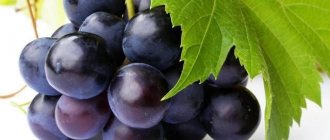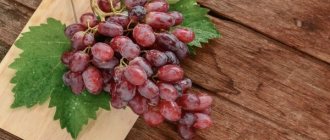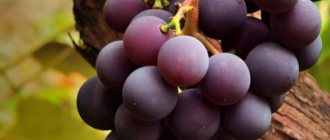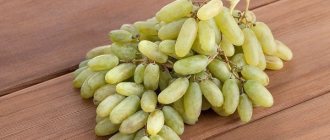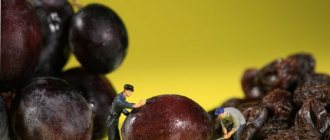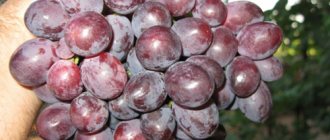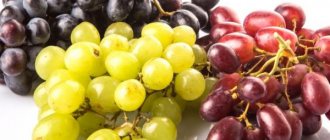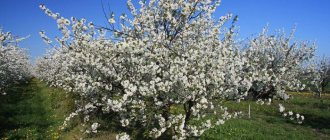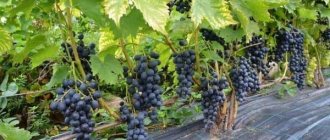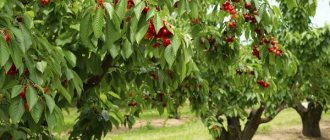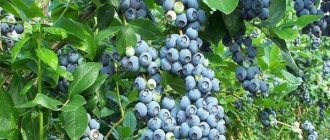Fruits and berries » Grapes
0
1034
Article rating
Kira Stoletova
Blue grapes are a storehouse of vitamins. It has a beautiful appearance and wonderful taste. The lines of the poem that Akhmatova wrote confirm this: “the smell of blue grapes is sweet... The intoxicating distance teases...”
Blue grape varieties
The best blue grape varieties with descriptions and photos
Content:
Yield plays a key role when blue grape varieties are grown for sale. But not only the abundance of the harvest is important, but also its quality, so below are the most productive and delicious blue varieties, which are in great demand.
- " Strashensky " ripens in 135-145 days. Productivity 250 c/ha. Table, has large, elongated clusters from 600 g to 1.5 kg, loose or dense type. The berries are round, weighing 6-12 g, dark blue. Sugar content – 19-20%, acidity 8.5 g/l. It has excellent commercial qualities, but is transported exclusively over short distances. It is not afraid only of phylloxera and spider mites; other pests and diseases require treatment. Frost resistance is average - up to -23 degrees Celsius.
- «Kishmish Jupiter» – a seedless, early-ripening variety of blue grapes. Productivity is 200-240 c/ha annually. The clusters are of medium size, conical in shape, 400-500 g each, only in rare cases does the weight exceed 800 g. The berries are small - 4-5 g, round and only slightly flattened. The color is dark blue with a purple tint. The pulp has a nutmeg aftertaste, juicy and sweet. Resistant to frost down to -30 g. Consumed fresh and processed into raisins.
Blue grape varieties are the most productive
- " Delight Black " also called Baron Black. Full ripening takes 115-125 days (mid-August). Grows quickly, yield 200 c/ha. The clusters are loose and dense, 450-750 g each, but there are also larger specimens weighing 1-2.3 kg. Conical shape. The berries are large with a high sugar content - 17.5%. The color of the peel is dark blue with a coating, the flesh is light and fleshy. Among the main disadvantages, it should be noted that it is demanding in terms of feeding and care; it also needs a lot of space to grow. Frost resistance -25 degrees. Resistant only to oidium and mildew.
- “ Nadezhda Azos ” is a blue grape that ripens in 120-130 days. Productivity 160 c/ha. The clusters are conical, loose, minimum weight 700 g, but with proper care they grow up to 2.5-3 kg! The berries are large, 8-10 grams, dark blue, elongated. The pulp is juicy, crunchy when biting, and sweet. Sugar content is within 17%, acidity – 7 g/l. Resistant to cold temperatures down to -22 degrees.
- " Muromets " is a blue table grape variety that ripens in 110 days. Productivity 160 c/ha. The clusters grow in a conical shape, weighing 500-1000 g. The berries are round, dark blue, with a bloom, weighing up to 5 g. The taste is sweetish with a nutmeg aftertaste, each berry has 1-4 small seeds. Sugar content – 17-19%, acidity 6-7 g/l. Resistant to cold temperatures down to -26 degrees.
- " Moldova " is a dessert grape variety, universally applicable and late ripening - 160-170 days. The bunches can be picked no earlier than mid-September. Productivity 150-200 c/ha. The vine of the plant is powerful, the leaves are dark green. The clusters have the shape of an inverted cone, the average size is 300-600 g. The berries are up to 6 g, oval, with a rather thick, but not hard peel (can be eaten). The color is dark blue, with a purple tint and a white coating. There are not many seeds - 2-3 large ones. Sugar content is 16-19%, acidity is 8-10 g/l. The pulp is juicy, plum flavor. Transportability is high, and winter hardiness is up to -26...-27 degrees.
What are the advantages and disadvantages of blue grape varieties?
In terms of agricultural technology and cultivation, blue grape varieties do not have certain common positive similarities, except for the presence of a waxy coating on top of the berries, which is a kind of protective layer. Growing, frost resistance, features of fertilizers, care, type of planting may differ depending on which variety is chosen and where it is grown (climate, soil).
The advantages that all blue varieties have relate, first of all, to their taste and beneficial qualities. They treat bronchitis, asthma, migraine, blood diseases, gastrointestinal tract, chronic fatigue. In this case, not only fresh berries are used, but also grape juice of blue varieties. Their taste is high, the berries are usually sweet, with a low acid content.
The advantages of blue varieties are primarily in their taste and beneficial qualities.
But blue grapes also have disadvantages. Its berries and juice should not be consumed if you have diabetes, kidney disease, liver disease, gastritis or ulcers. It is not recommended for people who want to lose weight. All varieties of blue grapes contain a lot of sugars - 16% or more, so you need to eat them in moderation - 15-25 berries per day no more.
Composition of black grapes
The benefits of black grape fruits for the body have long been proven. It is recommended for the prevention and treatment of many diseases. Beneficial substances are contained in the pulp, peel and seeds. Berries are valued for the following:
- They contain large amounts of antioxidants. There are more than 300 of them. These substances neutralize free radicals that damage cells and contribute to a decrease in immunity and the development of malignant tumors. Antioxidants are contained not only in the pulp, but also in the seeds, from which medicinal and cosmetic oils are made.
- The dark color of the berries is partly due to the high content of flavonoids, which have a positive effect on the heart and blood vessels. Resveratrol reduces cholesterol in the blood and counteracts the cancerous degeneration of cells. Querticin prevents platelet aggregation and blood clot formation.
- Phenolic acids in combination with flavonoids reduce cholesterol and even partially dissolve already formed plaques.
- Pectin or vegetable wax regulates the functioning of the digestive system and acts as a sorbent of toxic substances.
- Phytosterols have antioxidant properties, have a positive effect on the immune system, and counteract the proliferation of viruses and bacteria.
In addition to these biologically active substances, black grapes contain a lot of vitamins and minerals that are beneficial to health. The first place among them is occupied by ascorbic acid and vitamin K. Vitamin C improves immunity and strengthens capillaries. Vitamin K affects blood clotting. Beta-carotene improves night vision, skin, nails and hair condition, and immunity.
Composition of BJU (proteins, fats, carbohydrates):
- proteins (proteins) - 0.2 g;
- fats - 0.1 g;
- carbohydrates - 16.2 g.
BJU ratio: 1:1:98%
The calorie content of 100 g of product is approximately 2.8-3.5% of the daily value for humans. Indicators vary depending on the variety.
The benefits and harms of black grapes
Benefits of black grapes for the human body:
- improves memory and attention;
- relieves stress;
- normalizes liver function;
- has a positive effect on the heart;
- prevents cancer;
- improves vision;
- reduces sugar levels;
- reduces the intensity of cough.
Benefits for women:
- breast cancer prevention;
- normalization of hormonal levels;
- resumption of sexual desire;
- improving the condition of the skin.
Benefits for men:
- maintains potency;
- normalizes the functioning of the genitourinary system;
- improves spermatogenesis;
- prevents prostate adenoma.
Black grapes are harmful in the following cases:
- individual allergies;
- in the last weeks of pregnancy and lactation;
- obesity;
- presence of ulcers;
- oncological diseases of the stomach;
- diabetes mellitus;
- tuberculosis;
- diarrhea;
- swelling;
- chronic constipation.
Benefits of blue grapes
Besides being delicious, blue grapes are also healthy in many ways. It achieves this effect thanks to an impressive range of vitamins, trace elements and minerals.
Grapes help with recovery from illness. Thanks to the laxative effect, which is determined by the composition, namely the large amount of fiber and acids, the berries help with disorders of the gastrointestinal tract.
Berries also help with various heart diseases. Just include them in your diet. If you suffer from such an illness, then the berry will help you, but if not, then as a preventive measure, it will help you strengthen your body.
Blue grapes, if they don’t heal, certainly have a powerful positive effect during diseases such as:
- bronchitis;
- asthma;
- blood diseases;
- chronic fatigue.
Not only the fruits themselves can cope with diseases. Grape juice made from blue berries helps cope with migraines. You need to drink on an empty stomach, without diluting with water.
Grapes help cope not only with diseases. Berries have a positive effect on women. They bring great benefits to the health and beauty of women.
- freshness of the skin;
- good mood;
- stress relief;
- keeping yourself in good shape;
- invigorating effect;
- phytoestrogen content, which helps in the postmenstrual period;
- cancer prevention.
Berries can not only be consumed, but also used to make various cosmetic products to maintain the beauty and strength of hair. They are used by cosmetologists to produce creams, emulsions and serums. They contain a huge amount of vitamins that help maintain a young and fresh look, as well as care for your hair.
How does the berry affect during pregnancy? Thanks to the vitamins, minerals and macronutrients in the product, it helps strengthen the immune system and increase hemoglobin levels. Elimination of constipation during pregnancy occurs due to the large amount of fiber. And calcium and potassium contribute to the strengthening and proper development of the fetus.
Important! Since berries are included in allergenic products, you should not use the product during long-term pregnancy.
How are black grapes used?
Black grapes are quite widely used in the food industry. Some varieties are processed into drinks - wine or grape juice, while others are used to make jams and preserves. Dark grapes are also used as decoration for dessert dishes.
Black grapes are often used in cooking
Of course, the main use of grapes is winemaking. Black varieties are excellent for making table, dessert and fortified red wines, as well as cognac. Sometimes dark berries are used in the production of champagne. Grape fruits are also suitable for preparing non-standard drinks - liqueurs, tinctures and grape vodka.
Note! Berry seeds and skins are processed into extracts and used during aromatherapy treatments. Seed oils can be included in cosmetics.
Variety Autumn black
Autumn black was bred in Moldova by crossing the French varieties Alphonse Lavallee and Pierrell petite. It belongs to the table variety, with a medium ripening period. It takes 140 days from bud break to harvest.
In the northern regions, the variety requires shelter for the winter.
The grape crop has a beautiful appearance and is suitable for cultivation both on an industrial scale and in garden plots. Description of Autumn Black:
- tall bush;
- bisexual flower;
- clusters are large (up to 1 kg);
- the shape of the bunch is conical;
- productivity is high;
- fruiting is annual;
- high transportability;
- frost resistance is average;
- increased resistance to diseases.
The shape of the bunch is conical. The berries fit tightly, their shape is oval-oblong, the color is deep black.
The skin is not thick, the flesh is juicy, homogeneous, without inclusions. The taste is sweet and sour, balanced, harmonious.
Pruning - up to 35 eyes per bush. Blue grape varieties, such as Autumn Black, are demanding on the load, the weight of their bunches is not small, so the procedure for forming a bush is carried out regularly.
It is beneficial for the human body to drink freshly squeezed juice daily to replenish the required amount of vitamins and microelements. The properties of the berries allow them to be preserved for a long time.
Grapes Isabella blue grapes The most large-fruited form of blue grapes BENEFITS OF GRAPE | blue, dark, green grapes benefits
Variety Black Delight
Black delight was developed in Russia at the end of the twentieth century in Novocherkassk. To obtain it, we used a selection method with a combined scheme, which resulted in not only blue grape hybrids.
At the final stage, Black Delight received the qualities of Dawn of the North, Dolores grapes and Russian early. As a result of the work carried out, Vostorg has frost resistance, immunity to many diseases and early ripening of the fruit cluster.
Properties and qualities of the variety:
- tall bush;
- rapid vine growth;
- annual fruiting;
- high productivity;
- frost resistance;
- resistance to fungal diseases.
The ripening period is 130-135 days. High yield, ability for storage and long-term transportation allows Black Delight to be sold in all regions of the country, far from the place of cultivation.
The variety has large cylindrical clusters (up to 2 kg), large berries with a pleasant sweet and sour taste. Their skin is dense, dark in color, with an attractive black tint. The pulp is homogeneous. Sugar content - up to 10%. Berry weight is up to 6 g. Fresh juice is sweet and aromatic.
Odessa black
If you like homemade wines, then you should pay attention to this dark grape variety. It produces a rich, ruby-colored juice. It can be used to produce dry and dessert drinks. Harvesting will be possible for 160 days. Refers to late in terms of maturity. You can enjoy delicious and juicy berries at the end of September.
Odessa black
The brushes are medium in size, and their shape is elongated, shaped like a cone. The clusters are not located tightly in relation to each other. As a result, the density of the brush is insignificant. The clusters are of different sizes, and the weight reaches 130-280 g. The berries are presented in a round shape, the color of the peel is dark blue, and the consistency of the pulp is not dense, but very juicy.
There is a light waxy coating on the surface of the peel. One of the advantages of the variety remains its unpretentiousness and increased immunity to low temperatures. The peculiarity of this variety is that the plant is not susceptible to the influence of gray rot and powdery mildew. One-year and two-year-old seedlings are suitable for planting activities. They are planted in April-May. But what uncovered grape varieties exist for growing in Belarus, and what they are called, can be seen here.
The best wine grape varieties
The grapes from which juices and wine are made are called technical. The characteristics of the bunches look modest in comparison with table species:
- medium to small in size with densely spaced fruits;
- the average weight of the brush is 120-150 g;
- high juice content (75-85% by weight of the berry);
- sugar content exceeds 18%.
Wine grapes bear fruit consistently well. This is facilitated by the increased resistance of plants to fungal infections and pest attacks. Next, we’ll find out which variety is best suited for winemaking.
What can be made from blue grapes?
The useful product is used not only fresh, but also dried. The fruit is a raw material for the production of wines and grape liqueurs. At the same time, the berry is widely used in cooking. Here is a small selection of what can be made from blue grapes:
- compote;
- juice;
- jam;
- jelly;
- spot – non-alcoholic drink;
- syrup;
- grapes in their own juice;
- dried fruits (raisins, sultanas);
- vegetable oil.
The healthiest dietary product is juice. It contains natural carbohydrates, vitamins, and is quickly absorbed into the body.
An oriental sweet – churchkhela, a very nutritious dish. It is prepared from condensed juice, flour and all kinds of nuts (walnuts, hazelnuts, almonds).
Berries are used in fruit and vegetable salad recipes. They go well with various foods: apples, mangoes, oranges, bananas, kiwi, strawberries, cheese. The berries are used to decorate dishes and confectionery (cakes, pastries). A savory appetizer for meat is pickled grapes. Dolma, a favorite dish of the Caucasian people, is prepared using young grape leaves and minced meat.
A fruit basket with grapes will always come in handy
Table varieties of black grapes
There are many varieties of black grapes
Table varieties have become popular in recent years. They have a rich and refined taste. High-yielding and winter-hardy hybrids have been developed, which is why grapes are cultivated in different regions. Several interesting varieties:
- Moldova, or the Black Prince. A late variety, harvested in the third decade of September. The berries are oval, with a dense skin and a white pectin coating. Fruit length - 25 mm, diameter - 19 mm, weight - about 6 g. Sugar content is high, up to 20%, increases during storage. The pulp is juicy, with a plum flavor. The mass of the bunches is 300-600 g.
- Kishmish, or black kish-mish. This variety is suitable for the production of raisins and fresh consumption. The berries are oval in shape with a flat base and are richly covered with pectin, which gives them a blue tint. The middle is dense, aromatic, with a characteristic crunch. The clusters are medium, conical. The variety is seedless, some fruits have small reduced seeds.
- Orchid. An ultra-early variety that is suitable for growing at home. It is frost-resistant and has good disease resistance. The clusters are large, cone-shaped. The fruits weigh about 12 g and resemble fingers with a sharp tip. The skin is of medium thickness and does not crack. The pulp is dark red, juicy, crunchy.
- Autumn. A late variety with large clusters, weighing up to 500-700 g. The flowers are bisexual, the fruits are oval or ovoid, dark blue, measuring 27x22 mm. The pulp is dense. Productivity is high. The variety is prone to cracking and is affected by gray rot.
- Mercedes. Ripens in the second half of August. The fruits are large, oval, painted black. The taste is sweet. The variety belongs to the table dessert variety and has low acidity.
- Moscow. A variety with increased frost resistance and high yield. The clusters are large, conical, often winged. The fruits are oval, with a wide base, there are 2-3 seeds inside, and there are berries without seeds. The taste is sweet, the yield is high.
- Black crystal. This is an extremely early hybrid variety, its ripening time is 90-110 days. The flowers of the vine are bisexual, the berries are shaped like an egg with a narrowed base, weigh 10-12 g. The bunch is large, often weighing more than 900 g.
- Widow. A new hybrid variety with large fruits, weighing up to 20-25 g. The fruits are a rich dark shade and have the outline of a regular oval. The taste is sweet, the middle is compacted, crunchy.
- Panther. A variety with large sweet fruits, their length is up to 35-40 mm, weight - more than 15 g. Oval shape, dark purple color. The top of the fruit is covered with white pectin. The pulp is full of juice, sweet, reminiscent of Moldova grapes. The clusters are moderately loose, weigh 700-1200 g.
- Kishmish Black Sultan. This is a seedless variety that ripens early. The fruits are spherical, slightly elongated, small, weigh up to 3 g, sweet in taste and juicy. The bunch is a cylinder or cone, dense, its weight is 300-700 g.
- Emerald. A variety with high yield, 2-3 clusters ripen on one shoot, which weigh on average 0.5 kg. The fruits are elongated, weighing up to 5 g, charcoal in color, with a soft skin and a crispy center.
- Cherry. Original grapes with cherry flavor. The clusters are large, up to 1.2 kg. The berries are elongated, 36x22 mm in size, dark, ripen early. The variety is praised for its good winter hardiness.
- Magic. An early table hybrid that is harvested in summer. The clusters weigh 500-700 g, compacted. The fruits are large, ovoid, weigh 6-8 g, the skin is strong. The taste of the pulp is sweet and sour.
- Baron. The ripening time of this variety is 120-125 days. The clusters are massive, weighing 700-900 kg, sometimes reaching 2.5 kg. The fruits weigh about 7 g, dark blue, round in shape. The center is crispy and juicy, with a spicy aftertaste.
- Nadezhda Azos. A variety with vigorous bushes. The clusters are loose or slightly compacted, their weight is 400-600 g. The fruits are elongated, each weighs 7-8 g, the taste is sweet and sour, simple.
- BCZ, ChBZ or In Memory of Dombrovsky. Seedless grapes with good frost resistance. The flower has both stamens and pistils; the clusters are winged, cylindrical, and weigh up to 1.5 kg. The berry is round, dark blue, weight - 2.1-2.5 g. It tolerates transportation well.
- Lucy. Variety with female flowers, large conical clusters. The fruit is large, weighing up to 8 g, nipple-shaped. The peel is dense, the center is bright red. The fruits ripen at the end of August, do not crack and do not attract wasps.
- Husayn. A southern species growing in Central Asia. The clusters are medium-sized, resembling a narrowed cone. The fruits are dark blue, oval, and have narrowed tips. The peel is strong, coated with pectin, the middle is juicy.
- Beak. Grapes with heavy, shapeless clusters that weigh up to 1 kg. The fruits are hook-shaped, dark, weigh about 15 g, have a size of 36x22 cm, do not burst and are not damaged by wasps.
- Crow. Early grapes, ripening in late July or early August. It is distinguished by massive clusters and large crispy fruits with thick skin. The taste is sweet, with a slight sourness and mulberry aftertaste.
- Crimean. This is a table variety that is grown on an industrial scale. The clusters are elongated, cylindrical-conical in shape, sweaty, weigh about 300 g. The grapes have black berries, large, oval or ovoid, with dense skin and juicy pulp, a small amount of seeds.
- Souvenir. A variety with high and constant yield. The clusters are conical, loose, elongated, weigh 250-300 g. The fruits are large, ovoid, elongated, with a nutmeg-thorn flavor.
- Rock. Winter-hardy variety with early ripening. The harvest is harvested in some areas when summer is just entering its second half. The clusters are heavy, up to 800 g. The fruits are oval-shaped, some weigh 30 g.
Table black varieties are very popular among gardeners. They are also grown on an industrial scale. Some are universal, used for wine production.
Black emerald grapes USEFUL PROPERTIES OF GRAPES and why they are so valued! Healing grapes Black Doctor: medicine or delicacy?
Forum statistics
207036 Messages in 1634 Topics from 5593 Users. Last user: Amaya Last message: “Let's talk about the weather in Vash...” ( Today at 07:52:22 ) Latest messages on the forum.
Now on the forum
78 Guests, 10 Users
Users in the last 15 minutes: sergei, ALEX, Ser, Evgeniy 163, Elvira2017, Lyubov S., Erem, Ekaterina Polyanina, ElenkaF, kosmos [Blocked] [Section Moderator] [Forum Moderator]
Maximum online today: 100 . All-time maximum online: 2758 (28 July 2021, 17:22:51)
Users who visited the forum in the last 24 hours
Total: 295
(Visible: 294, hidden: 1) 1963, sergei, Alex, ser, Evgeny 163, Elvira 2017, Love S., EREM, EREM, Ekaterina, Elenkaf, Kosmos, Evgeniy52, Yura, Galina Anokhina, Dorontsovpeter, Zaycevas, Alex65, 77volt, 77volt, 77volt, 77volt, 77volt, 77volt, 77volt, 77volt, 77volt 64nikolay64, Vova Kapran, Vasily 53, zsb, Polina77, spotlight, Mikhail Alekseevich, Svetla777, Quiet, Marshal, Nikolay S., therapist, Liza, Capricorn, lomakin1969, Alexander Vl., Andrey76, Slavka, Mikhail77, Tatyana B, Cherkessk, Eugene, Leonidych, vladimirM, yotmast, mers, Serg1707, SNovichek, hanter64, znakomij, Alexander K, Vardan, Sergey Fer, Anatoly Sivkov, Alexey V, Ilya 77, Andrey Gladilin, Tatyana A., Belgorodets, in Astrakhan, Oksana Kopp, sem_en, Vladimir 153, skier, Igor Viktorovich, slavalimon, Primorets, OlgaOs, SANYCH, 31rus, mystic69, Andrey Tsvetkov, Buba, igor222, Elena Z, vlad51, Kenig, Nikolay Rex, Sergey 1965, Vladimir Buturlakin, DSW, psv1960, Dmitry 77, Vasily V., Vyacheslav03, Natalia Nikolaevna, Sergey Tashchiyan, Igor Sergeevich, alexsandr, kvg, Pioneer, nicson7, Elena Aleshchenko, Alexander-ask-34, Verona, Igor F., Taker, Henry, Yuri72, L.A. P., Gaivoronsky Yuri, Sergeevich, Sergey Chistokletov, Svetlana Streletskaya, Galinka, Alexey Deminov, Naumov Igor, Vyacheslav136, Gloomy, Katrin, AndSanych, Mikhno Alexander, Ded31, Filippov Oleg, Vladimir ++, Lydia58, ALEXANDER BRYANSKY, Vladimir-kanevskaya , DIL, Amber7394, Marina Protasova, TITOVA LYUBOV, Linx, alexander66, Natalya M, Mikhail Fesenko, Amaya, Alexander71, Boris 1952, tsv, Maximilian, 25nata35, nadia, Igor_K, Alexander Kolesnikov, Ivan Levin, Pitko, weather forecaster, eSAa, cecet71, atseton, Alexander Smirnov, Vladimir Kostochkin, Vladimir Berdnikov, Gocha, pioneer-2, LeXa_KoT, Sergey 61, Sergey Yuryev, alexss, Skif, Vladimir Kovba, dayton, Yuri Semyonov, N.A. Sokolov, Pavlentiy, Sa-shura , Volgogradka, Dmitry Anatolyevich, Grandfather Igor, Andrey Lis, Bublichenko Alexander M, Marina Krymskaya, stenlly2010, irahelm, Vyacheslav Vladimirovich, Vladimir Shilov, Aprel, Badaev Dmitry, gheo55, y_fed, rambo, Yagodka, Valentina Ivanovna, Kryn, oleg9f, DED 2 , Korotina Svetlana, Oleg Ivanovich delivered, Eduard., santra, L2k2m7n, Alexander48, Viknik, Andrey 31, m2d, Valery Rastorguev, soshnin yura, Amateur gardener, Galina, vasily1111, gardener, marlin64, Salex, Sergey Ko, Ramiz, victor_ , potap05, Yuri 36, VitalySD, Inna161, Vladimir Shcherbinin, Valerie, niy1, cfibr, Andrey68, kulol3, thanatos, Serzh1978, Realist, Artur53, max2008-01, LOZA, AlexanderD, Ded Young, Natasha, Zayac, ketch, Rita, alx-74, Iv Iv, Alexander150, Igor K, Vasily Viktorovich, VeraNiK, kdm57, Veniaminovich, Boris Sokolyansky, , vikbublik, neposny, Evgen, Victoria Aleksandrovna, Serezha 64, Wintel, Airbone, teri, Sergey Lomonosov, Khramov, serginio, Leonty Yarygin, Irina O., Nadezhda Grig, netolya, Saisan, Alexey Agryzkov, Vadi, Zinaida, Vadim, Alexander Taganrog, Sergey Sukhonos, Snezhinets, evgen_26, nau_63, Masha_gardener, Gennady163, krasnovlad1, Alexander Zinoviev, Roman Fedorovich, TIS, Alexey Sergeevich, Arnyusha, Zheka, Nurtas, kradievska, nick041, Valentina Medvedeva, Sergey43, Andrey S., Nikolay Lipunov, Mst, Vertuoz2, Vladimir VS, NatalyaMed, freesia, Kinna, Mikhail Michurinsk, alekcsan1, VALERY TAMB, Sasha57, MikhAf, Y_Azer , Andrey Beribesov, hunter1955, nut lover, Keys, Ivan Shmelev, Pestle, anton_slash, Nadymchanka, Sergey 31, Volgar, Pavel 64, Tatyana Volzh, Elektronik_t, Alexander 61
Benefits for women
What are the benefits of blue grapes for women? The sunny fruit not only brings health to a woman, but also helps preserve female beauty and attractiveness:
- its constant use preserves youthful skin in women;
- lifts your mood, relieves stress;
- fruit juice is included in the menu for weight loss;
- berries tone, invigorate and are a natural aphrodisiac;
- the seeds contain phytoestrogen, which is useful for women during the postmenstrual period;
- fruit squeezes are used by cosmetologists to combat premature skin aging;
- Moderate use of berries prevents the development of breast cancer.
Berry extract is used in cosmetology for the production of creams, emulsions, serums for the face and body. This plant contains a huge amount of vitamins, phytonutrients, and minerals that allow the production of anti-aging cosmetics and hair care products.
How are blue grapes beneficial for a woman’s body and can they be consumed during pregnancy? A large amount of vitamins and minerals contained in berries helps strengthen the immune system and increase the level of hemoglobin in the blood. The fiber and pectin content can solve the problem of constipation for pregnant women. Berries contain large amounts of calcium and potassium, which are necessary for the development of a child.
The product is contraindicated in women who are gaining excessive weight. Doctors recommend including blue fruit in a pregnant woman’s diet if the baby’s weight is below normal.
Please note that these berries are allergenic products. It is not recommended to take them during long periods of pregnancy due to the development of flatulence.
Features of blue grape varieties
Varieties of blue grapes in the color of their berries are close to wild varieties of the crop, the fruits of which can be dark blue, dark purple, almost black. All other variants of fruit colors appeared thanks to human efforts.
In most cases, the blue tint is inherent only in the skin of the fruit; the pulp, like the juice, is characterized by transparency. The color is determined by the concentration and nature of the location in the tissues of the peel of such substances as:
- chlorophyll, carotene, xanthophyll (antoxanthins);
- quercetin, quercetin (flavones);
- anthocyanin pigments.
The varietal characteristics of blue grapes are associated with the taste, nutritional and medicinal properties of the product, while differences in plant agricultural technology are rarely due to the color of the berries.
Specifics of care
Varieties with dark fruits may have different ripening periods, purposes, yield levels, stability - these indicators determine the basic needs of the plant. But blue grapes also have specific requirements for agricultural technology:
- The crop should not be allowed to ripen in direct sunlight; dim light is more beneficial. In view of this, minimal leaf thinning is required to improve air circulation on the bush, otherwise the berries will be faded, unevenly colored, and may get sunburned.
- It is necessary to ensure sufficient saturation of the plant with potassium and magnesium. With a deficiency of substances, the ripening of dark-colored fruits occurs with a delay, and the color becomes less saturated.
Healthy! In this case, an arched or arbor formation is preferable, since it allows you to create a protective canopy of leaves over the clusters. In second place is the cup-shaped shape.
Beneficial features
Blue grapes contain many substances valuable for human health:
- vitamins C, E, PP, as well as all B vitamins with the exception of B7 and B12;
- antioxidants - beta-carotene, resveratrol, glutathione, melatonin and others (about 300 compounds in total);
- organic acids - tartaric, succinic, oxalic, glycolic, malic, gallic, citric, tartaric, salicylic and others;
- bioflavonoids – proanthocyanidins, quercetin, quercetin;
- phytosterols;
- tannins;
- minerals - iron, calcium, potassium, magnesium, phosphorus, zinc, copper, iodine, boron, cobalt, sulfur and molybdenum.
In general, all types of grapes have a similar chemical composition, but, depending on the color of the berries, they may contain a higher or lower concentration of individual substances, which determines the degree of usefulness of the product for diseases. Medicine confirms the beneficial effects of dark grapes on such aspects of human health
| Effect on the body | Useful substance |
| Strengthening the heart muscle. | Resveratrol, copper, potassium. |
| Increasing the elasticity of blood vessels, normalizing blood pressure. | Bioflavonoids, copper. |
| Reducing cholesterol levels, preventing blood clots. | Antioxidants. |
| Strengthening the immune system. | Vitamins, antioxidants. |
| Stimulates bowel function (laxative). | Organic acids, fiber. |
| Activation of hemoglobin production. | Iron. |
| Increasing the resistance of mucous membranes to damage by bacteria and viruses. | Tannins. |
| Stimulating brain activity, improving memory, increasing stress resistance, preventing senile dementia and Alzheimer's disease. | Bioflavonoids, copper, phosphorus. |
| Reducing the risk of tumor formation. | Antioxidants. |
| Prevention of thyroid diseases. | Iodine. |
| Normalization of hormonal balance in women. | Bor. |
| Removal of radioactive substances from the body. | Pectin substances. |
| Extending youthful skin. | Bioflavonoids. |
People suffering from diabetes, diseases of the liver, pancreas, stomach, intestines, or a tendency to diarrhea should avoid eating this treat.
Interesting! The incidence of cardiovascular disease among the French is almost 40% lower than that of other Europeans with a comparable standard of living. Scientists tend to associate this phenomenon with the tradition of systematic wine consumption.
Advantages and disadvantages of blue varieties
The choice of grapes of one shade or another is a matter of taste, but objective advantages and disadvantages can be found in dark varieties in comparison with others. Among the first are:
- The largest proportion of substances beneficial for the cardiovascular system.
- Lower glycemic index than light fruits - 44-54 versus 44-58, therefore, less increase in blood sugar levels when eaten.
- The presence of a waxy coating on the skin, which can also occur in some representatives of light varieties. The prune layer creates additional protection against bacteria, mechanical damage, and the negative effects of weather conditions. Due to this, the shelf life of fruits and resistance to transportation are, on average, higher.
- The attractive appearance of dark blue berries makes them a sought-after product.
- Blue varieties can be used to make both red and white wines, while light ones are only suitable for the production of white drinks.
- A vine with black clusters has the most decorative appearance, which allows the bushes to be used to decorate gazebos or hedges.
Among the disadvantages it should be noted:
- Higher calorie content than that of white fruits - 69 kcal/100 g and 43 kcal/100 g. Strictly speaking, in both cases the indicator is considered average; for comparison, green peas have an energy value of 70 kcal, but for people suffering from excess weight, such a difference can be significant.
- The product has a negative effect on tooth enamel, manifested in its darkening.
- Dark fruits are more likely to cause allergies than white or pink ones.
- The need for additional care measures at the time of harvest ripening.
Features and characteristics of blue grapes
Blue grapes contain glucose, so they are quickly absorbed by the human body. According to nutritionists, the caloric content of grape fruits is at the level of potatoes and milk. Research has shown that one kilogram of blue grapes contains approximately 300 grams. sugars
Blue grapes should be classified as plants that bring great benefits to the human body. It contains many vitamins, microelements, sugars (glucose, fructose). Scientists have proven that grape wines are capable of removing metal salts and radionuclides from the body. Drinking red wine helps hematopoietic processes in the body; dry wines help fight sclerosis. It has been observed that residents of those countries who regularly drink various wines suffer less from heart disease.
Variety Athos
Athos has been grown in large farms since 2012. It is a table variety with an early ripening period. It is used for making juices and for producing red and rose wines.
The variety has excellent characteristics:
- vigorous bush;
- flowers are bisexual;
- shoots are brown;
- the nodes on the shoots are red;
- the vine is powerful, brown;
- leaves are slightly pubescent.
The bushes grow tall. The varieties Muromets, Bashkir Black Original and Anthony are characterized by the same shape and size of the bush as the Atos variety.
The shape of the bunch is conical. The berries fit tightly, without peas, reach a weight of 12 g. The color of the berries is almost black, the shape is elongated, with a sharp end. The skin is thick, but crispy and tasty. The reddish pulp has a juicy and balanced taste.
Leaves with a characteristic dissection, round and dark green.
It takes no more than 100 days for the crop to fully ripen. At the end of July - in the first week of August, mass collection begins.
Because of its sweetness, Athos is attractive to birds. To prevent them from harming the crop, drinkers should be hung on the stems of the vine.
The beneficial properties of berries are strengthening the immunity of adults and children, replenishing the body with pectin, enzymes and fiber.
Compound
The benefits of blue grapes for the human body are due to its composition. The main part of the product is water, accounting for up to 80%. The content of main macronutrients is: protein - 0.6 g, fat - 0.2 g, carbohydrates -16.8 g per 100 g of berries. The fruit is rich in tannins, essential oils, dietary fiber, enzymes, as well as saturated and unsaturated fatty acids. The value of the blue berry lies in its high content:
- B vitamins (B1, B2, B3, B5, B6, B9);
- ascorbic acid;
- vitamin E;
- biotin;
- vitamin PP.
This vitamin complex is necessary for the normal functioning of the human body. At the same time, blue fruits contain vital microelements:
- calcium;
- magnesium;
- potassium;
- iron;
- zinc;
- cobalt.
It should be noted that the peel of the blue fruit contains phytosterols, bioflavonoids, essential oils, quercetin, and sugars.
On the site you will also find a description of the following grape varieties: Amur, Moldova, Victor, Rochefort, Kishmish, Libya, Cardinal, Lydia, Isabella, Arcadia. Read here what are the benefits of grape seeds. Basic properties of black, red and green grapes.
About the benefits of grapes, or Grapes are different - blue, yellow, green, red...
Light grape varieties
In second place are the types of grapes with white, pink, red, amber-yellow and green skin colors. The color of the berries depends on the content of flavonoids of different chemical structures. Flavones and flavonoids give yellow coloring, causing the color shades of light grape varieties. Quercetin - a red plant pigment, a substance from the flavonoid group - belongs to the vitamin P group and, together with the acids contained in berry juice, reduces the permeability and fragility of vascular capillaries, thereby providing an anti-edematous and anti-inflammatory effect; prevents platelet aggregation; improves the rheological properties of blood; reduces the level of “bad” cholesterol. Knowing this, grapes can be used to prevent heart and vascular diseases - hypertension, atherosclerosis, thrombophlebitis, stroke.
Anthocyanins give the berries their pink color. The more of them there are in the skin, the richer the color.
Red, pink, and purple colors come from anthocyanins. Just like dark blue berries, these berries have antioxidant, antitumor, lipid-lowering, anti-inflammatory and anti-clotting properties, but to a lesser extent. This is understandable - after all, in terms of resveratrol and quercetin content, they are inferior to dark-colored berries. However, due to the sufficient content of vitamins, flavonoids and antioxidants, juice from these grape varieties is recommended for digestive problems , blurred vision due to glaucoma and cataracts.
Grape juice speeds up water-salt metabolism, removes excess uric acid, and prevents the formation of stones and sand in the urinary tract. These properties make it possible to recommend taking the juice for disorders of the genitourinary tract , gout and urolithiasis.
Grape juice replenishes energy reserves
One glass of freshly prepared grape juice contains the daily requirement of B vitamins . These include thiamine, riboflavin, pyridoxine, folic and pantothenic acids, which stimulate the transmission of nerve impulses in the muscles and the central nervous system. That is why grape juice is recommended for people with high physical activity, especially since it is the leader in iron content and easily digestible carbohydrates. The juice is also useful for athletes, because it not only relieves muscle tension and fatigue, but also replenishes energy reserves.
You will be surprised, but grapes with red or pink berries can easily be called natural antibiotics. It is these berries that contain phytoncides that destroy pathogenic viruses and bacteria. Of course, grapes cannot replace medications, but taking berries to prevent influenza or ARVI is an excellent solution!
Particularly beautiful are the soft pink grape bunches with the graceful shape of the berries.
If a cold has knocked you down, grapes with muscat flavor will be an excellent addition to drug treatment. Due to the expectorant effect of saponins in the skin of muscat grapes, the viscosity of sputum decreases and the cough goes away faster. Do you remember the subtle unusual aftertaste of the berries? The aromatic substances that give this nutmeg flavor reduce swelling of the mucous membranes of the nasopharynx and relieve nasal congestion during colds.
Stilbene enzymes, found in all parts of red and pink grape varieties, contribute to the production of the valuable antioxidant resveratrol. And they themselves are very useful: they reduce the content of low-density lipoproteins and increase the content of high-density lipoproteins. This leads to normalization of blood cholesterol levels and improvement of liver function.
Choose grape varieties with light-colored berries in our catalog, which contains offers from major online stores of seeds and planting material. View a selection of grape seedlings with light berries.
Grapes TUKAI, 1 pc. 495 RUR
seedspost.ru
AUGUSTOVSKY grapes, 1 pc. 395 RUR
seedspost.ru
Grapes ALESHENKIN, 1 pc. 495 RUR
seedspost.ru
Fruit grapes Bianka 319 rub.
Agrofirm Search
A distinctive feature of white and green grapes is their lower sugar content than other varieties, so you can safely eat them without fear of gaining weight. And during pregnancy, in case of edema, it is good to eat yellow-green grape berries with a pronounced diuretic effect. It is advisable that these grapes be grown at home without the use of chemicals.
Variety Black Monukka
One of the most beautiful and delicious blue grape varieties is Black Monucca. It has several other names: Kishmish, Kara Kishmish, Shuvargany. It was bred in Central Asia, then it spread throughout the world.
Description of the oriental variety Black Monukka:
- vigorous bush;
- productivity is high;
- frost resistance is low;
- susceptibility to disease;
- mid-ripening;
- seedlessness.
The leaves are funnel-shaped, covered with a network of wrinkles, dark green, with a characteristic strong dissection, three-lobed and pubescent below.
The clusters are medium in size, cylindrical or cone shaped. The berries do not fit tightly. The shape of the berries is oval, the color is dark, blue-black. By the time they are fully ripe, a light whitish protective coating appears on them.
The skin is thin, pleasantly crunchy on the teeth. The taste is completely balanced.
The benefits of blue grapes are obvious. Chemical analysis confirms the presence of trace elements and vitamins A, B, E. Its low calorie content allows it to be eaten while on a diet, dried or fresh.
Variety Black Pearl
The variety is distinguished by early ripening of fruits
Black pearls were obtained through selection at the Potapenko Research Institute. Hybrids August and Centaur were used for crossing. Another variety is called Black Pearl.
The variety has become widespread in areas with industrial winemaking. Blue Pearl grapes are useful both fresh and frozen.
Characteristics of Black Pearl grapes:
- tall shoots;
- the edge is bare;
- petiole short;
- leaves are five-fingered, pubescent;
- frost resistance;
- instability to fungal diseases;
- early ripeness.
The castings are dark green, with characteristic cuts. The harvest is ready for harvest at the end of August. The sugar content in fruits is up to 25% with an acidity of 7-8 g/cu. dm.
The clusters are conical, medium size (up to 350 g). The berries are aromatic, with a nutmeg flavor. Their color is dark purple, almost black. The bush survives frosts down to -30°C.
